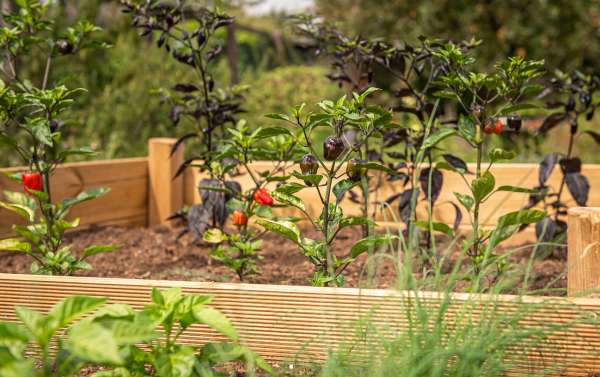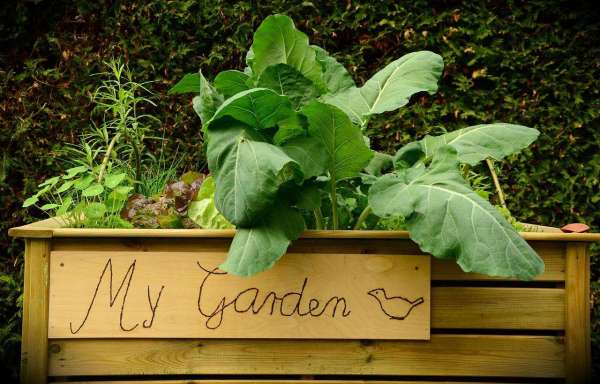
Source: Pixabay
Raised-garden-bed gardening is also known as container gardening. It’s very helpful for people with limited mobility, older people, people in wheelchairs, and even kids.
Raised garden beds can help in making gardening easier and more comfortable. Also, in some urban areas, where there are no other options, container gardening can be your go-to way to grow your own healthy and organic food.
You can buy pre-made garden beds in garden centers but you can also build them on your own. It is not so hard and you will be thrilled with the result.
Let’s dig right into it!
5 Steps On How To Build A Raised Garden Bed
When building a raised garden bed there are a few important things you have to consider. For example, you have to think about how tall the bed should be – or how much you want to bend, and more. Here are some useful tips.
Define the size and the height of the garden bed
Raised garden beds can come in different sizes and heights. It all depends on your preferences and the vegetables you want to grow.
The first and most important thing is deciding how much bending over you can or want to do. If you have limited mobility – the best solution is a tall garden bed where you can easily grow all kinds of plants. If you opt for a taller garden bed – bear in mind you might need to install additional structural support.
If mobility is not an issue, and you prefer the look of a more shallow garden bed – think about the roots of the vegetables you plan to grow and adjust the height accordingly. Here are some examples:
- radishes, spinach, and strawberries have shallow roots (up to 18 inches)
- carrots, turnips, and cucumber needs at least 24 inches, while
- sweet potatoes, tomatoes, and pumpkins need tall garden beds (35 inches or higher).

Image source: Pixabay
Choose The Location
Choosing the right location is vital for a raised garden bed. The more direct sunlight your garden receives, the better. Avoid shady spots and go for a site that receives more than eight hours of sunlight daily.
If you are building multiple raised garden beds, it’s a good idea to arrange them parallel to each other and facing south. That way you will get maximum sunlight, and the plants won’t cast shadows over each other during the day.
If you live in a windy area, think about caring for your taller plants either by choosing a protected location or building a trellis and supporting them in that way.
Choose The Material
You can build your raised garden beds from all kinds of materials. The most popular are wood, brick or stone raised beds. All materials have their pros and cons.
- Wood is relatively affordable and looks great in your garden. It’s also very easy to use – even if you are a beginner raised-bed builder. A pro tip if you select wood is to treat it with some kind of a preservative so it lasts longer. To avoid the preservative leaching into your soil, you can lay a plastic groundsheet liner before filling the bed with soil.
- Stone is another great-looking natural material. Something to be conscious of with this choice, it can absorb a lot of heat. Be sure to consider the heat tolerance of your plants if proceeding with a stone bed.
- Brick is also used to build garden beds. Raised garden beds made from bricks can last a lifetime but the downside is that you lack flexibility with these kinds of beds. Also, you will need a construction expert.
Prepare The Soil
After choosing the location and the material, it’s time to prepare the soil for your garden bed. The great thing is that you have full control of which type of soil you are putting in your beds. So if you are planting succulents – you can mix humus with gravel for better drainage.
Also, you can do the same thing if you are planting spices like rosemary or oregano. Those are Mediterranean plants that don’t need a lot of water, and they will be a great addition to your shelf with spices.
For other plants, add quality organic compost mixed with sand for proper drainage. Most plants need at least 10 inches of soil to grow, but some need more. After adding the soil, wait for two weeks and then add more compost on the top.
These beds dry up quickly, so you must water them appropriately. In a week, you may need to water them up to three times. No doubt that the watering process can be tiresome with poor-quality equipment, but having a retractable garden hose which is easy to maneuver around your garden will make your watering a breeze.
Prepare The Ground
First, measure the size you want, to get the correct wood measurements and mark out the footprint for your garden bed on the ground. Also, ensure that you can easily reach the other side of the garden bed without stepping on it.
Then, remove all the rocks and debris from that space so that you can install a ground barrier. Usually, the best choice is cardboard or hardware cloth — they help prevent pests and weeds from accessing your plants underground.
Another option is to leave your garden beds open on the bottom so the plant roots can access soil nutrients below the ground level. In this case, you’ll have to dig deeper into the ground so your plant’s roots can penetrate into the soil.
Building The Raised Garden Bed from Timber

Image source: Pixabay
After clearing the ground, you can now build your garden bed. You will need:
- Timber planks – recommend a minimum 2” thickness
- Electric saw (or hand saw if you like the extra work!)
- Cordless drill
- Drill Bits
- Tape-measure
- Spirit Level
- Deck Screws
- Hardware cloth or cardboard (if you want to install a ground barrier)
Once you gather all the required materials, follow these steps:
- Prepare the ground barrier: Remove all staples and tapes from the cardboard, then spread it to the desired area.
- Cut your wood. Grab your timber and cut it into two equal pieces for width and two for length — or four equal pieces if you’re going for a square floor plan. Depending on the size of your bed, decide on the appropriate timber thickness which will be able to hold the entire construction together.
- Ensure that the boards are level on the ground. If not, you can dig them into the garden until they are level.
- Drill some pilot holes to enable you to screw the timber together without splitting. The drill bit needs to be thinner than the diameter of deck screw you will use to fasten the planks. Have all four sides in place for your pilot holes so you can be sure the lengths and attachment points line up for a perfect rectangle.
- Screw the timbers together. Fasten all four corners using your deck screws.
Advantages of Raised Garden Beds
Raised bed gardening is simple and enjoyable. Because of the elevated design, it will benefit from naturally good drainage for plants’ health.
In an ordinary garden, you don’t always have control over the soil. But in a raised garden bed, you have complete control over the soil quality and texture, as you are filling it yourself.
You’re also capable of preventing pests and weeds from damaging your plants from the ground by using hardware cloth or cardboard as a barrier.
These garden beds are ideal for any size space. You can easily rotate your plantings, or separate your plants as they grow.




